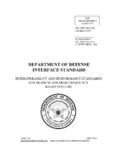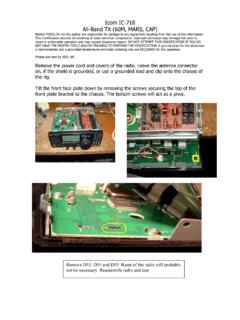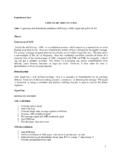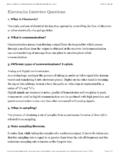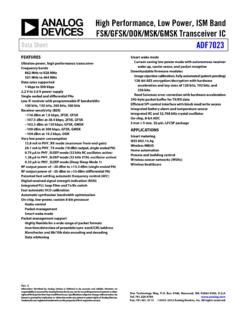Transcription of HF Serial-Tone Waveform Design - HFLINK
1 33-l HF Serial-Tone Waveform Design Jorgenson and Moreland Communications Research Centre 3701 Carling Ave. Ottawa, Canada, K2H 8S2. Summary tion commonly used at HF will be provided before focusing on the serial tone Waveform . The essential The intent of this paper is to provide the reader with elements of a modem Serial-Tone modem will be an understanding of the findamental aspects of HF described, as will their impact on the Design of a Serial-Tone Waveform Design . Factors which affect Waveform . Empirical relationships for predicting the the Design of a Waveform are discussed.
2 Some fac- bit-error-ratio (BER) performance of Serial-Tone tors are regulatory, for example, the availability of modems in a Doppler spreading environment are bandwidth. Others are a consequence of nature, provided. Finally, the paper will conclude with a such as the characteristics of the HF channel. The Waveform Design example, based on the authors technology used in the detection of Serial-Tone sig- experience in specifying Annex G of STANAG. nals plays a key role in the Design of the Waveform . 5066. Dach of the component elements of a Serial-Tone modem is briefly described.
3 Empirical Waveform What is a Waveform ? per$ormance rules are presented and the Design pro- cess is illustrated with an example based on the A Waveform specification is a description of the on- development of a 9600 bps HF Waveform standard. air signalling used to transmit a digital data signal over a radio channel. It includes a complete specifi- Introduction cation of the modulation to be used and prescribes the known symbols, commonly referred to as initial With the increased demand for high data rate HF training (IT) or preamble, that are sent to establish services, HF Waveform Design is enjoying a renais- synchronization as well as any other known symbols sance of sorts.
4 New HF waveforms have been devel- which may be inserted to aid in the demodulation oped for NILE/Link-22 and STANAG 4444, and are process. Many standards, particularly more recent being developed for STANAGs 4538, and 4539. A efforts, include forward error correction coding and Serial-Tone standard for data rates up to 9600 bps data interleaving as an integral part of the definition. was provided in STANAG 5066 Annex G as a non- mandatory component of the standard. The Annex G As a rule, Waveform standards only specify the Waveform was a commercial success in that it was details of the Waveform to be transmitted.
5 It is up to implemented by vendors, even before adoption. vendors to determine how best to demodulate the When Annex G was removed from STANAG 5066, signal, although some standards, notably the US. the same Waveform , with minor modifications to the Mil-Stds, specify minimum performance figures preamble, interleaver, and the addition of another which must be obtained in order for a vendor's intermediate data rate, found its way into draft Mil- equipment to be considered compliant with the vari- Std 188-l 10B. ous standards. This paper will provide a tutorial guide to designing Factors affecting Waveform Design an HF Serial-Tone Waveform and is intended to give the reader sufficient background to make judge- A number of factors affect the Design of a wave- ments regarding the suitability of various proposed form.
6 One of biggest constraints for HF Waveform waveforms. We will begin by describing the compo- Design , particularly in recent years as the emphasis nents which make up a Waveform and the key fac- has shifted to higher data rates, is the channel band- tors to consider in Waveform Design . For reference width. For military uses, HE spectrum is typically purposes, a brief description of the types of modula- allocated with a 3 kHz channelization, although Paper presented at the RTO IST Symposium on Tactical Mobile Communications , held in Lillehammer, Norway, 14-16 June 1999, and published in RTO MP-26.
7 33-2. there are exceptions: some naval broadcasts operate and has resulted in new and developing standards in a kHz bandwidth and there are some assign- for waveforms offering rates of 9600 bps and ments of 6 kHz for use with independent sideband greater. The context in which these systems are radios (typically for Link-l 1). 3 kHz is a respectable being developed is also changing. At one time, bandwidth for sending a 75 bps data signal, typified EMCON considerations were considered paramount by the naval broadcasts run by many NATO nations, and most HF transmissions were one way, with no but it becomes a very narrow piece of spectrum for acknowledgment to give away information on the users who are attempting to transmit at data rates of recipient's position.
8 Increasingly, military forces are up to 9600 bps. considering options which involve radiating detect- able emissions for substantial portions of the time The unique characteristics of the HF channel itself during operations. This evolving change in philoso- offers significant challenges. The ionospheric phy, coupled with the advent of modem automatic refraction which allows HF radio signals to propa- repeat request (ARQ) systems, has led to the trans- gate over long distances is not without its shortcom- mission of data types which require error free recep- ings.
9 The received sky-wave signal may suffer tion (executable computer programs, for example). distortion in the form of temporal dispersion (delay spread) as well as fluctuation in the signal's ampli- tude and phase (Doppler spreading). Recent high Modulation Types latitude DAMSON measurements have observed One way of characterizing modulations is to multipath signals of more than 10 ms duration and describe them as either bandwidth efficient or power other signals have shown evidence of Doppler efficient. Examples of bandwidth efficient modula- spreading greater than 50 Hz [ 1,2].
10 More typical tions are phase-shift-keying (PSK), quadrature mid-latitude sky-wave channels might show delay amplitude modulation (QAM) and multi-carrier spreads of 1 - 4 ms with Doppler spreads of 1 Hz or modulations. Power efficient modulation types less. In addition to the sky-wave channel, the HF. include direct sequence spread spectrum and M-ary surface wave channel offers interesting features and frequency shift keying (MFSK). It is noteworthy challenges. Over sea-water, the HF surface wave that all of the above listed modulations have been propagates far beyond line-of-sight, offering intrigu- used at HF.
